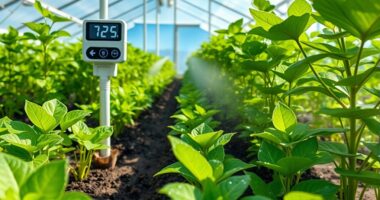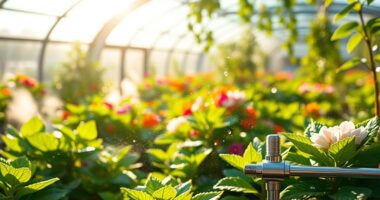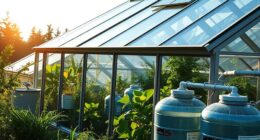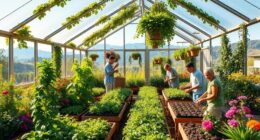Growing herbs in a greenhouse lets you enjoy fresh, flavorful herbs year-round by creating the ideal environment for healthy growth. Consistent watering suited to each herb’s needs, combined with proper soil drainage, keeps plants vibrant. Controlling temperature and humidity through ventilation prevents mold and fungal issues, ensuring your herbs stay productive. Maintaining good airflow and monitoring conditions help prevent problems. Keep these tips in mind, and you’ll soon master year-round herb cultivation within your greenhouse.
Key Takeaways
- Maintain consistent, proper watering tailored to each herb’s needs to ensure healthy, vibrant growth year-round.
- Use well-draining soil and monitor moisture levels to prevent overwatering and root diseases inside the greenhouse.
- Implement effective ventilation systems, such as automatic vents or exhaust fans, to regulate temperature and humidity.
- Regularly monitor environmental conditions and adjust watering and ventilation to optimize plant health throughout the year.
- Select greenhouse materials and setup that support climate control, promoting continuous fresh herb production regardless of season.
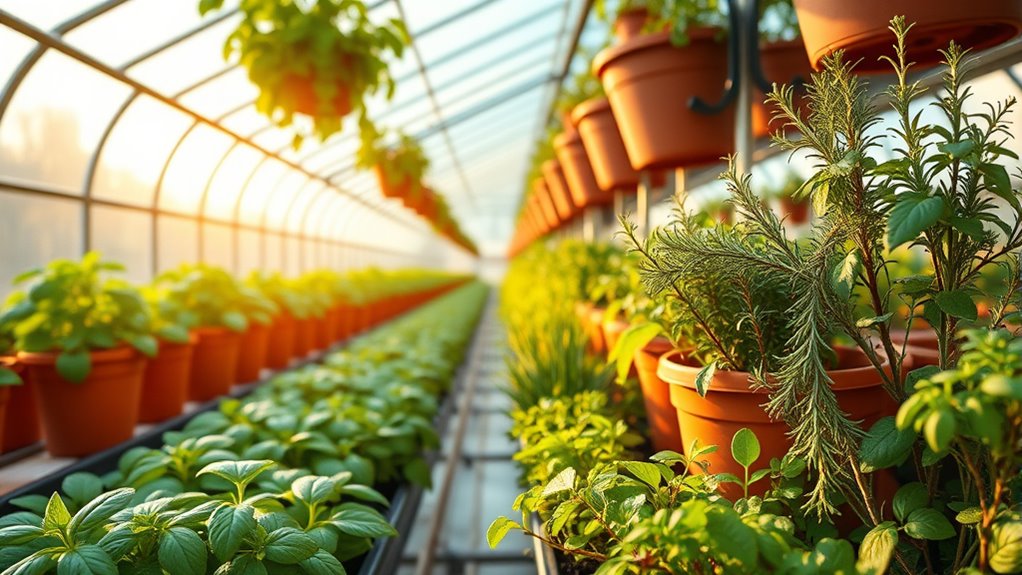
Growing herbs in a greenhouse offers a convenient way to cultivate fresh, flavorful plants year-round. When you set up your greenhouse correctly, you create an ideal environment where herbs thrive regardless of the season. One of the most important aspects to contemplate is herb watering. Consistent, appropriate watering ensures your herbs stay healthy and vibrant. Avoid overwatering, which can lead to root rot, and under-watering, which stresses your plants. Implement a watering schedule that matches the needs of each herb—many prefer moist but well-drained soil. Using drip irrigation or self-watering containers can make this task easier, providing steady moisture without the risk of waterlogging. Pay attention to the soil’s moisture level regularly; your herbs will thank you for their proper hydration. Proper watering practices are essential to prevent issues like fungal diseases and ensure optimal growth. Regular monitoring of soil moisture can help you fine-tune your watering routine and prevent problems before they arise.
Equally vital is greenhouse ventilation, which helps regulate temperature, humidity, and air circulation. Proper ventilation prevents the build-up of excess heat and humidity, both of which can promote fungal diseases and diminish plant health. When the greenhouse gets too warm, especially during summer, opening vents or installing exhaust fans allows hot air to escape and cooler air to enter. Good airflow keeps humidity in check and helps prevent mold and mildew, which can quickly infect your herbs. During colder months, ventilation helps prevent condensation that can lead to damp conditions harmful to your plants. Installing automatic ventilation systems can further optimize airflow and reduce manual adjustments, ensuring consistent environmental control. You should also consider installing adjustable vents or windows so you can tailor airflow based on weather conditions, maintaining a consistent environment inside your greenhouse. Additionally, incorporating temperature monitoring devices helps maintain optimal conditions for herb growth. Moreover, selecting the right greenhouse materials can influence the overall climate control and energy efficiency of your setup. Proper air circulation not only benefits herb health but also enhances pest and disease management, creating a healthier growing environment overall.
Balancing herb watering and greenhouse ventilation creates a healthy, stable environment for your herbs to flourish. When you water appropriately, your plants absorb the nutrients they need, promoting lush growth and flavorful leaves. Meanwhile, proper ventilation ensures that the internal climate remains suitable for herbs, which often prefer a slightly humid but well-ventilated atmosphere. It’s essential to observe your plants closely—look for signs of overwatering like yellowing leaves or soggy soil, and signs of poor ventilation such as wilting or fungal spots. Adjust your watering schedule and ventilation setup accordingly to keep your herbs happy and healthy. Maintaining an optimal environment with proper airflow management can significantly enhance your herb-growing success.
Frequently Asked Questions
What Are the Best Herbs for Beginner Greenhouse Growers?
If you’re starting as a greenhouse grower, pick easy herbs like basil, mint, and parsley. These are great for beginners because they thrive with simple watering techniques and respond well to herb companion planting, which helps keep pests away naturally. You’ll find these herbs forgiving and fast-growing, giving you confidence and fresh flavor in no time. Focus on consistent watering and good airflow, and you’ll enjoy a successful herb garden.
How Do I Prevent Pests in a Greenhouse Herb Garden?
Think of your greenhouse as a fortress against pests. To keep it secure, practice natural pest control by introducing beneficial insects and using companion planting. These methods create a balanced ecosystem where pests find fewer targets and natural predators thrive. Regularly inspect your herbs, remove affected leaves, and avoid overwatering. With these strategies, you’ll maintain a healthy, pest-free environment, ensuring your herbs flourish year-round.
Can I Grow Herbs Indoors Without a Greenhouse?
Yes, you can grow herbs indoors without a greenhouse. Use indoor herb containers that fit your space, ensuring they have proper drainage. Place them where they get plenty of sunlight, ideally 6-8 hours a day, or supplement with grow lights if natural light is limited. Keep the environment warm and avoid drafts. With the right sunlight and container setup, you’ll enjoy fresh herbs all year long.
What Soil Type Is Optimal for Greenhouse Herbs?
Did you know that the right soil can boost herb growth by up to 20%? For your greenhouse, opt for a well-draining, loamy soil rich in organic matter. You should regularly add soil amendments to improve fertility and make sure the pH balance stays between 6.0 and 7.0. This creates an ideal environment, helping your herbs thrive year-round. Proper soil setup is key to lush, healthy herbs in your greenhouse.
How Do I Extend the Herb Harvest Season Naturally?
To extend your herb harvest season naturally, focus on season extension techniques like using cloches, cold frames, or row covers to protect herbs from harsh weather. You can also plant herbs in well-insulated containers and place them in sunlit spots indoors or in your greenhouse. These natural methods help keep herbs thriving longer, allowing you to enjoy fresh herbs throughout the year without relying on artificial heat or grow lights.
Conclusion
Think of your greenhouse as a secret garden treasure chest, bursting with fresh herbs all year long. With the right care, you’ll open a constant supply of fragrant leaves to elevate your cooking and brighten your days. Greenhouses turn your herb-growing dreams into a lush reality, no matter the season. So, roll up your sleeves and nurture your green oasis—you’re cultivating more than herbs; you’re growing a lifelong delight.


